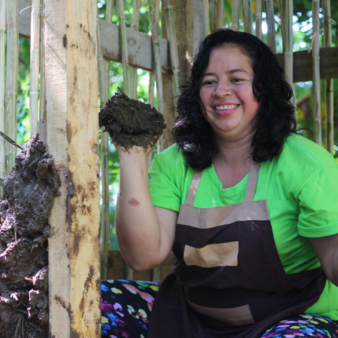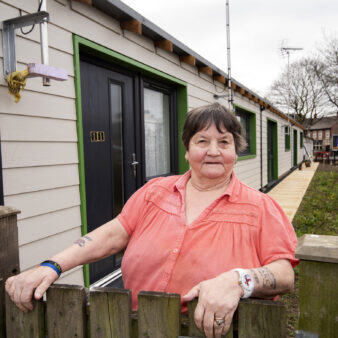This pilot project involves a cluster design for 57 low-cost dwellings on degraded highland near the city of Delhi. The project shows how land previously classified as unfit for development can be used, as well as demonstrating innovative design and construction systems. Careful design prevents encroachment and trading in the dwellings. Innovative systems of sanitation and water supply are to be maintained by the community.
Project Description
Aims and Objectives
- To identify how the re-housing of slum dwellers can be carried out in a more affordable and sustainable manner whilst at the same time providing sufficient infrastructure and dealing with the problem of scarce land supply.
Delhi is one of the fastest growing metropolises in India. Out of its population of 14 million, 4 million live in slums. The major problems faced in Delhi, as in other Indian cities are lack of funds, non-availability of land and infrastructure. These are exacerbated by incorrect planning, the inadequacies of the government mechanism and the failure of past development approaches. Providing housing for the slum dwellers is a perennial problem that seems to defy all plausible solutions and the problem continues to outpace the solutions. In the area of Jaunapur Project however, there is no shortage of land or funds to deal with the slum problem but only a shortage of political will.
The appalling conditions in which the slum dwellers of Delhi (and other cities in India) currently live are the housing problems addressed by the Jaunapur Slum Resettlement project. This is an innovative approach to solving the slum problem of Delhi that requires one to look beyond the current systems of the Delhi Public Works Department.
The 52 dwelling units were built in 1997 as a pilot project for a scheme of re-housing 3,600 former slum households of the Southern Ridge area of Delhi. Contrary to standard procedures, degraded highland rather than flat land was used for the settlement on the hilly outskirts of the City. The Lt. Governor of Delhi instructed that the pilot project proceed in order to allow further examination of the unconventional approaches being pioneered. Bureaucratic and political infighting has prevented the occupation of the site to date and legal moves are currently underway to allow it to be occupied.
The dwellings are designed in clusters of 9 dwellings grouped in a ‘through cluster’ rather than an enclosed court. Each cluster is provided with 2 toilets, one bath, one washing area and one court in common. Each dwelling is 15.8m2 and is capable of vertical extension to 31.6m2. The overall density is 210 dwelling units per hectare.
The dwelling units are designed as skeletal structures with a structural framework and a roof provided. These can then be completed by the residents, reusing materials from their earlier homes. Residents are expected to contribute in terms of labour and materials to infill the structure and assistance is provided to them to obtain the materials and bring them to the site. The houses have been filled in with hollow blocks made in the local building centre. Individual and community toilet facilities both have their problems and the solution here is a midway one, i.e. having community facilities in each cluster. This also has the advantage of reducing the potential of the unit as a tradable commodity. The soil on the site is highly absorptive and has been used to wastewater and the sewage locally. Sewerage and wastewater is treated locally on the site and fruit plantations will be established using the resultant by-products. Water supply is a gravity flow through pipes into underground tanks in the centre of each cluster.
A range of construction materials and techniques have been used. Funicular shell roofing gives greater strength and uses less material than conventional roofing systems. The use of steel and cement is minimised. There is efficient use of RCC in the structural framework and roofs are built with waste stone quarried locally on the site and there is no need for steel reinforcement. The hollow concrete blocks are used for the walling and training will be provided by the local Building Centre to future residents in how to make these.
The total cost per dwelling is $1,100 including site development costs (compared to $2,000 for conventional municipal resettlement costs). The total project cost for all 3,600 residents will be $4.5million including infrastructure, compared to $8.0 million if carried out by the Public Works department of the Delhi municipality.
Why is it innovative?
- Community management of infrastructure
- Prevention of encroachment
- Non-tradability of units
- Demonstration that land classified as ‘unfit for development’ can be successfully used.
- Innovative construction systems and techniques.
- Careful planning and layout of the settlement to ensure social sustainability.
What is the environmental impact?
Building materials used to construct the houses are locally produced and resource efficient. A water conservation scheme is included within the design to make sure that the best possible use is made of the water used and to reuse it to support fruit plantations.
Is it financially sustainable?
Funds for construction are largely dependent on municipal funding of slum resettlement and rehabilitation. The residents are required to provide the labour and materials to complete the basic house structure provided for them. A range of income generating opportunities will be available to residents. These include the provision of small retail spaces in the communal areas of the final settlement and the provision of a local transport system.
What is the social impact?
Cluster grouping of dwellings helps to create group identity and the layout is designed to prevent encroachment. The provision of clean water, sanitation and adequately ventilated dwellings will ensure that the living conditions are healthier than the slum areas of the city where the residents lived previously. Training will be provided by ABC to enable residents to extend and improve their homes.
Transfer
The scheme is eminently transferable since it identifies a logical and cost effective approach to land selection, infrastructure planning, material usage and cluster planning to provide a comprehensive settlement plan.
ABC was commissioned to carry out a similar project in Jamaica (Vedaville Development Project) and plans for this were presented to the Prime Minister of Jamaica in August 2002.
Partnership
NGO


